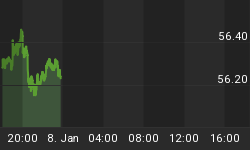The dollar's rally against the Euro lasted all of one day. On Tuesday, the greenback reversed most of its Monday gains, providing a boost for commodities and TIPS alike. Bonds continued to float slightly upward (lower in yield), with the 10y rate at 3.37%. Stocks rose 0.6% amid generally positive earnings, although it bears note that Goldman had a 20% 'beat' and the shares fell anyway. If that happens on a widespread basis, it would be cause for further concern about index levels and the possibility that amid stretched valuations "selling in May" might make more sense than usual.
On the economic front, Housing Starts showed a solid 7.2% rise over an upwardly-revised February figure. The resulting 549k level of Starts is still putrid (see Chart), but I always hasten to remind readers that a low level of starts is a good thing given the big overhang of unsold homes.

Housing Starts: above expectations but still sickly.
And that is, more or less, the extent of the news on another slow trading day. Tomorrow's data provide another cut at the housing market, and a more important one, with Existing Home Sales (Consensus: 5.00mm from 4.88mm). Existing Home Sales has been very volatile for a long time now, thanks to the many and sundry incentive programs stopping and starting, but the headline sales number isn't the most important figure anyway. Look at the "Homes Available For Sale" subindex, which was last at 3.488mm and a mild uptick. We want to see that back around 2-2.5mm eventually, but for those looking for improvement in the housing sector any improvement will be welcome. The recent low, in January 2010, was 3.277mm; below that and it would be the lowest since 2006 (yes, existing home inventories were an obvious problem as far back as that).
There will also be a continuing deluge of corporate earnings reports to pepper us throughout the day.
Since it was a fairly light day news-wise, I want to turn for a moment to a complaint I hear quite a bit when I discuss commodity indices and related strategies with clients and potential clients. Our 'Four Real' strategy currently has a 52% weight in a commodity index, and the classic objection is "I can't invest in that - I need more diversification!"
So let me talk about diversification.
The people who say this, almost uniformly, have no problem holding 80% of their portfolio in equities. They assiduously 'diversify' their holdings of stocks so that they hold, perhaps, 15 or 20 names, or a 'diversified' equity fund.
If the alternatives are between holding a diversified equity portfolio and holding 50% of your portfolio in a single commodity - yes, even gold - then I have no disagreement. But a commodity index is diversified by its nature. More than that, it is actually considerably more diversified than an equity index. After all, it is the equity markets that brought you the concept of "beta," which is a security's covariance with the broader market index. What is the "beta," on the other hand, of Feeder Cattle? It is nonsense to even think of such a thing. Almost all stocks have a positive 'beta' over short, medium, and long-term horizons. There is an old saying: "never confuse genius with a bull market;" this saying derives from the fact that if the market as a whole is going up, virtually every stock will also be going up too.
Let's make this more concrete. The standard deviation of the 5-day returns of the 500 elements of the S&P 500 from Monday the 11th through Monday the 18th was 2.68% - that is, roughly two-thirds of the changes were between +2.68% and -2.68% from the average change and virtually all of them were between +5.4% and -5.4% from the average. By contrast, the standard deviation of the 5-day changes of the 24 commodities contained in the GSCI was 4.13%. In this admittedly coarse illustration/snapshot, the components of the commodity index were 54% more "spread out" than the components of the S&P 500. In other words, the components were more diversified.
(As I have mentioned here before, that's good for another reason as well. It is the volatility of individual elements of a commodity index, combined with the low correlation between them, that creates a return stream tied to the periodic rebalancing of the index - you sell what has gone up and buy what has gone down, which systematically adds return. Equity indices, which are much more correlated, derive much less return from this source).
None of this means that a commodity index can't be as volatile, or more volatile, than an equity index; although historically they have had similar volatilities there are times when a commodity index has been more volatile than equities and vice-versa. And investors may of course differ on their expectations for returns. So there may be reasons that a particular investor is uncomfortable making as large an allocation to commodities as they would be willing to make to equities. However, I hope that I have successfully argued that "lack of diversification" shouldn't be one of those reasons.
















